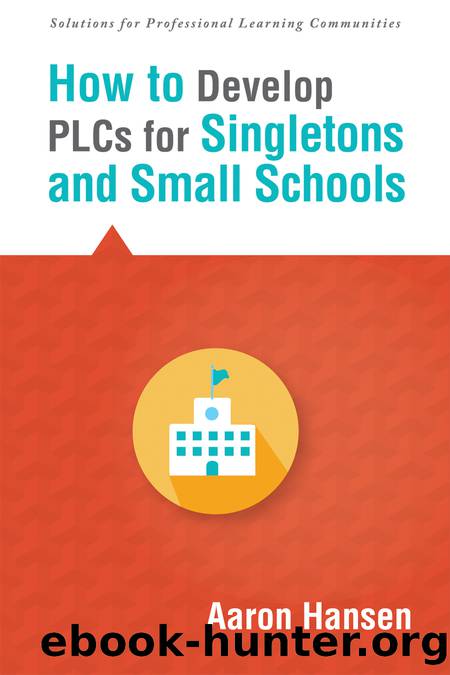How to Develop PLCs for Singletons and Small Schools by Hansen Aaron;

Author:Hansen, Aaron;
Language: eng
Format: epub
Publisher: Solution Tree
Published: 2015-08-15T00:00:00+00:00
B.
Mantle
C.
Core
D.
None of the above
He or she recognizes that students not only will have to learn the content vocabulary crust, mantle, and core, but also will have to understand the meaning of outermost. By creating a secondary vocabulary list, this teacher is able to support students with learning disabilities or language deficits, as well as help the rest of the team be intentional about direct instruction. This way, the team can better plan with all studentsâ needs in mind.
The special education teacher in a support role doesnât necessarily determine the content to be taught; however, he or she can help the team determine the best way for students to access the content the first time. By including the special education teacher in planning sessions, the team has a fresh set of eyes to help anticipate studentsâ initial challenges. Often, this teacher reviews the content that is planned and is able to identify one or two students he or she knows will struggle. These efforts often end up benefiting the whole class. A popular analogy is that of a wheelchair ramp. A school may build a wheelchair ramp so a specific student with a disability can access his or her classroom. However, many other students also will use the ramp as they enter the classroom. Although the special education teacher may design vocabulary maps or provide other scaffolds for a few individual students, those same scaffolds likely will benefit many students. For this kind of initial support, the special education teacher must be in the planning session and understand that this is part of his or her role on the team.
When the team assesses and reviews its data, the special education teacher should be involved. He or she can work with the team to determine specific learning deficits of all the students, and then the team can provide appropriate and targeted interventions, not just pull out students with individualized education plans (IEPs; see Buffum & Mattos, 2014, chapter 2).
Schools regularly make the mistake of assigning a special education teacher to participate in three or four different grade-level teams, which is not practical. Often, these teams meet at the same time, making it impossible for the special education teacher to truly be part of each team or attend regularly. Even if the teams meet at different times, the special education teacher usually gets spread so thin that he or she can do little to contribute to the success of any team. It is best if the special education teacher works with one or maybe two grade levels or department teams, at most.
Counselors also are often singletons who support. Because of the role the counselor usually plays, he or she may be assigned to meet with multiple teams. The counselorâs role is to meet with the teams about specific students who are struggling with problems or conditions that might impede academic progress. Because the counselor meets with multiple teams, he or she needs to have a schedule of regular meeting times. The team should know ahead of time which day the counselor will attend the team meeting.
Download
This site does not store any files on its server. We only index and link to content provided by other sites. Please contact the content providers to delete copyright contents if any and email us, we'll remove relevant links or contents immediately.
The Art of Coaching Workbook by Elena Aguilar(50998)
Trainspotting by Irvine Welsh(21521)
Twilight of the Idols With the Antichrist and Ecce Homo by Friedrich Nietzsche(18508)
Fangirl by Rainbow Rowell(9104)
Periodization Training for Sports by Tudor Bompa(8173)
Change Your Questions, Change Your Life by Marilee Adams(7638)
This Is How You Lose Her by Junot Diaz(6800)
Asking the Right Questions: A Guide to Critical Thinking by M. Neil Browne & Stuart M. Keeley(5651)
Grit by Angela Duckworth(5525)
Red Sparrow by Jason Matthews(5392)
Paper Towns by Green John(5092)
Room 212 by Kate Stewart(5041)
Ken Follett - World without end by Ken Follett(4647)
Housekeeping by Marilynne Robinson(4349)
The Sports Rules Book by Human Kinetics(4299)
Double Down (Diary of a Wimpy Kid Book 11) by Jeff Kinney(4208)
Papillon (English) by Henri Charrière(4199)
The Motorcycle Diaries by Ernesto Che Guevara(4018)
Exercise Technique Manual for Resistance Training by National Strength & Conditioning Association(3959)
